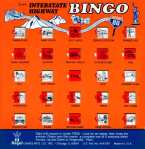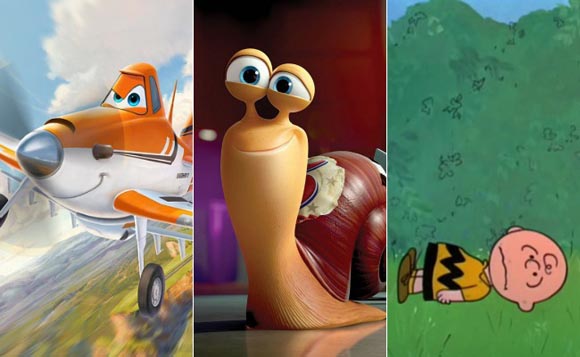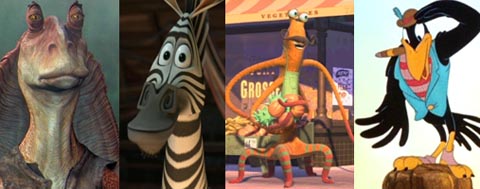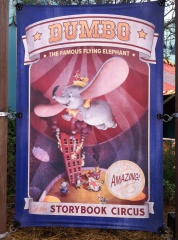Director Tim Burton will be seeing pink elephants for Disney.
Add a CommentViewing: Blog Posts Tagged with: Dumbo, Most Recent at Top [Help]
Results 1 - 7 of 7
Blog: Cartoon Brew (Login to Add to MyJacketFlap)
JacketFlap tags: Cinderella, Disney, Feature Film, Alice in Wonderland, Tim Burton, Beauty and the Beast, Dumbo, Sean Bailey, Add a tag
Blog: Cartoon Brew (Login to Add to MyJacketFlap)
JacketFlap tags: Dumbo, Cartoon Brew-ED, Marc Hendry, Educational, Add a tag
Student Marc Hendry has put together an in-depth analysis of the use of design and animation principles in the 1941 Disney film "Dumbo."
Add a CommentBlog: Cartoon Brew (Login to Add to MyJacketFlap)
JacketFlap tags: Ehren Kruger, Disney, John Lasseter, Dumbo, Add a tag
Disney is developing a live-action feature based on the 1941 animated film Dumbo. Ehren Kruger, who has written or co-written three of the four Michael Bay "Transformers" films, will write the script
Add a CommentBlog: (Login to Add to MyJacketFlap)
JacketFlap tags: God, Change, inspiration, Disney, Faith, Christian, Christianity, Dumbo, Add a tag
 As a child of the 70’s, I can remember trips from Louisville to Denver every summer with nothing but Auto Bingo to keep us happy. Those were long trips. I’m sure Kansas is a fine place, but the interstate roadsides were vast wastelands to a hot, bored kid. My lovely wife drives a Honda Odyssey and we recently took it on vacation. The van has a DVD player in it for rear entertainment, which totally blows my mind. What I wouldn’t have given to have that in 1974!
As a child of the 70’s, I can remember trips from Louisville to Denver every summer with nothing but Auto Bingo to keep us happy. Those were long trips. I’m sure Kansas is a fine place, but the interstate roadsides were vast wastelands to a hot, bored kid. My lovely wife drives a Honda Odyssey and we recently took it on vacation. The van has a DVD player in it for rear entertainment, which totally blows my mind. What I wouldn’t have given to have that in 1974!
The kids decided to watch only Disney classic movies on the trip and chose Dumbo first. I love that movie and actually enjoyed listening to it from the driver’s seat. Most of the others lost too much of the story when I was blind to the action. I could follow Dumbo quite well while the miles rolled by.
The crows are my favorite part of the movie. While I understand the regrettable stereotype that some associate with them, I see them as deep and compelling characters. When I See an Elephant Fly might be my favorite Disney song. Although unintended by writers, their scene with Dumbo shows me two important lessons.
1. I believe people (and possibly crows) can change. When we first meet them, the crows are sarcastic and mock our hero’s dilemma until Timothy dresses them down for their behavior. Their response is one of true contrition and remorse as evidenced by the fact that they soon teach Dumbo to fly. The dialogue is priceless:
Crow: [as Timothy and Dumbo walk away sadly] Hey brother, now wa-wa-wait a minute. You don’t hafta leave feelin’ like that. We done seen the light. You boys is okay.
Timothy Q. Mouse: Please. You’ve done enough.
Crow: But we’s all fixin’ to ‘hep ya. Ain’t that the truth, boys?
Great line: “We done seen the light.” I once lived in darkness, but praise God, I saw the light. Light is available to anyone. It takes only a sliver of light to start a radical change.
2. I believe faith is more important than ability. No one really had any idea if Dumbo could fly. There was quite a risk in pushing him off a ledge with only a feather and his ears. But Dumbo believed that if he had the feather, he could fly.
Likewise, there is a point at the end of my ability where I need to trust in God’s plan for my life and His reckless love for me. Letting go of the ledge is incredibly hard, but success happens, not holding onto the ground for dear life, but out in the air with the feather. When He has promised to join me in flight, why would I stay on the ground?
Hebrew’s 13:5 says, “I will never leave thee, nor forsake thee.”
As I write this, I confess there are ledges that fear has me clinging to. I’m prayerfully inching closer to the edge.
What ledge are you holding onto?
Blog: Cartoon Brew (Login to Add to MyJacketFlap)
JacketFlap tags: Ideas/Commentary, Feature Film, Planes, Dumbo, Turbo, A Boy Named Charlie Brown, Add a tag

Luke Epplin writes convincingly in The Atlantic about the supremacy of the ‘magic-feather syndrome’ in kids’ animated features, which is the idea stemming from Dumbo that a character can do anything as long as they build up their self-esteem. The concept stretches back further, too. For example, The Little Engine That Could. Recent film like Planes and Turbo are both guilty of this phenomenon, according to Epplin:
Following one’s dreams necessarily entails the pursuit of the extraordinary in these films. The protagonists sneer at the mundane, repetitive work performed by their unimaginative peers. Dusty abhors the smell of fertilizer and whines to his flying coach that he’s “been flying day after day over these same fields for years.” Similarly, Turbo performs his duties in the garden poorly, and his insubordination eventually gets him and Chet fired. Their attitudes are all part of an ethos that privileges self-fulfillment over the communal good.
In addition to disparaging routine labor, these films discount the hard work that enables individuals to reach the top of their professions. Turbo and Dusty don’t need to hone their craft for years in minor-league circuits like their racing peers presumably did. It’s enough for them simply to show up with no experience at the world’s most competitive races, dig deep within themselves, and out-believe their opponents. They are, in many ways, the perfect role models for a generation weaned on instant gratification.
This predictable approach to storytelling is juxtaposed against the infinite riches of Charles Schulz’s comic Peanuts, and more specifically, the animated Peanuts feature A Boy Named Charlie Brown, in which Charlie Brown is denied instant gratification at every turn:
A Boy Named Charlie Brown might come across now as harsh and unforgiving–especially to audiences that aren’t familiar with the comic strip’s cruel undercurrents–but its lessons are more enduring than those from movies where characters fulfill their impossible dreams. Charlie Brown learns through Linus’s tough-love speech that failure, no matter how painful, is not permanent, and that the best means of withstanding it is simply to show up the next day to school with the fortitude to try again. Losing also forces Charlie Brown to come to terms with his own limitations. He can’t rely on a miraculous victory to rescue him from his tormented childhood. He followed his dream, it didn’t pan out, and he ends up more or less where he started, only a little more experienced and presumably with a little more respect from his peers. They may no longer be able to refer to him as “failure-face,” but Lucy still yanks away the football when he becomes too hopeful. It’s incremental, rather than life-altering, progress.
Epplin isn’t naive and knows that today’s market-tested, consumer-friendly animated features won’t take the kind of narrative risks that Schulz did in the 1960s. His suggestions for improvement are, nonetheless, quite sensible: “Contemporary animated films would never emulate the tough life lessons of A Boy Named Charlie Brown, but they’d do well to reintroduce the twin notions of failure and humility.”
The entire article is well worth a read, even if the release date of Dumbo is off by a couple years. And with a CGI Peanuts feature currently in the works, one hopes that the writers of the screenplay will stay true to the spirit of Schulz’s universe instead of following the cheap virtueless storytelling tropes of contemporary animation studio features.
Add a CommentBlog: Cartoon Brew (Login to Add to MyJacketFlap)
JacketFlap tags: New York Times, Disney, Racism, Cartoon Culture, Pixar, Asterix, Monsters Inc, Dumbo, Stephen Marche, Add a tag

Author Stephen Marche has a problem: he wants to share comics and animated cartoons with his son, but everything is racist. He told the world about his predicament in the most recent issue of the New York Times Magazine. He used the words ‘racism’ and ‘racist’ nine times to describe everything from Asterix to Dumbo to Tintin. Amazingly, Babar gets a pass because, Marche explains, “my son won’t be turned into a more effective colonist by stories of elephants riding elevators.”
Marche seems to lack a fundamental understanding of the cartoon medium, an art form whose essence is rooted in caricature and exaggeration. He finds offensive stereotypes everywhere he looks, including Blue Sky’s Ice Age, DreamWorks’ Madagascar and Pixar’s Monsters, Inc.:
Sulley and Mike, on the way into the office, happen to pass an orange squidlike grocer with a handlebar mustache who kind of talks-a-like-a-this. Perhaps that kind of stereotype is not as gruesome or upsetting as the one in the original Fantasia, but I had the distinct impression, as my son laughed at the scene, that my Italian immigrant grandfather was turning over in his grave.
Asterix gives Marche the biggest headache. As he reads it to his son, he wonders:
What is [my son] going to ask when I explain that for 400 years, white people took black people from their homes in Africa, carried them across the ocean in chains, beat them to death as they worked to produce sugar and cotton, separated them from their children and felt entitled to do so because of the difference in the color of their skin?
Amazingly, this thoughtfulness comes from a man who admits in the article that he told his son, “I don’t know why the pirates have a gorilla,” when his son asked him about a black character in Asterix.
I can only imagine that Marche would have a coronary if he ever watched this piece of animation:
PS – Go here to read a blistering takedown of Marche’s piece.
Cartoon Brew |
Permalink |
No comment |
Post tags: Asterix, Dumbo, Monsters Inc, New York Times, Racism, Stephen Marche
Blog: DIANE SMITH: Illo Talk (Login to Add to MyJacketFlap)
JacketFlap tags: hand, dress, figure, talking, contrast, mural, muralist, wine bottle, focused, Dumbo, Add a tag
I'm getting to the point in this panel where changes are smaller, so they may not be so obvious - little things here and there.
The most obvious addition was to start mapping out the wine bottle on the table. I plan to add something else on the table, but I haven't decided what exactly that's going to be (decisions, decisions). Also, you might notice that I've finally filled in the red dress, bringing that closer to completion.
Less obvious is the repaint touch-up of the purple grapes that was needed after previous adjusting of the figures. Also, I detailed the male figure's hand that's resting on the table - it had no definition and just blended in with the tabletop.
Last, but not least, I mixed up a darker dark for the grape leaves to add some deeper shadows and more contrast. Happier with the look of it now, but I may add another dark before the job is done.
One revelation that I had tonight was how much focused thought goes into painting (for me anyway). I know this because it seems that whenever I go out to paint, I am followed by a couple of kids - one that feels the need to be talking about everything that passes through her head (and this from the one we wondered if she would every talk)! I love having my kids by my side, but it's very hard to think about what I'm doing AND respond to her. I don't think I ever realized just how focused I am when working. I am now thinking that when my art class students are busy working, I should probably just shut up because they're probably not listening to anything I'm saying.
My other painting partner likes to buzz around on her own. But, tonight she thought it would be fun to "help" with the mural. She has her own paint brush, used to Disney Dumbo book as a "palette," climbed up on the step ladder, and got to work.
| Future muralists of America - UNITE! |




Still praying for you and your whole family. You won’t fall off of the edge, He has mighty big shoulders.
you are all in my thoughts and sometimes you just have to let go of the ledge and trust.
Thanks Levi. We are fighting and have a warrior on our side.
You have the Warrior of all Warriors!!!
Thanks Beth. (Insert cheesy song here) ‘I believe I can fly’